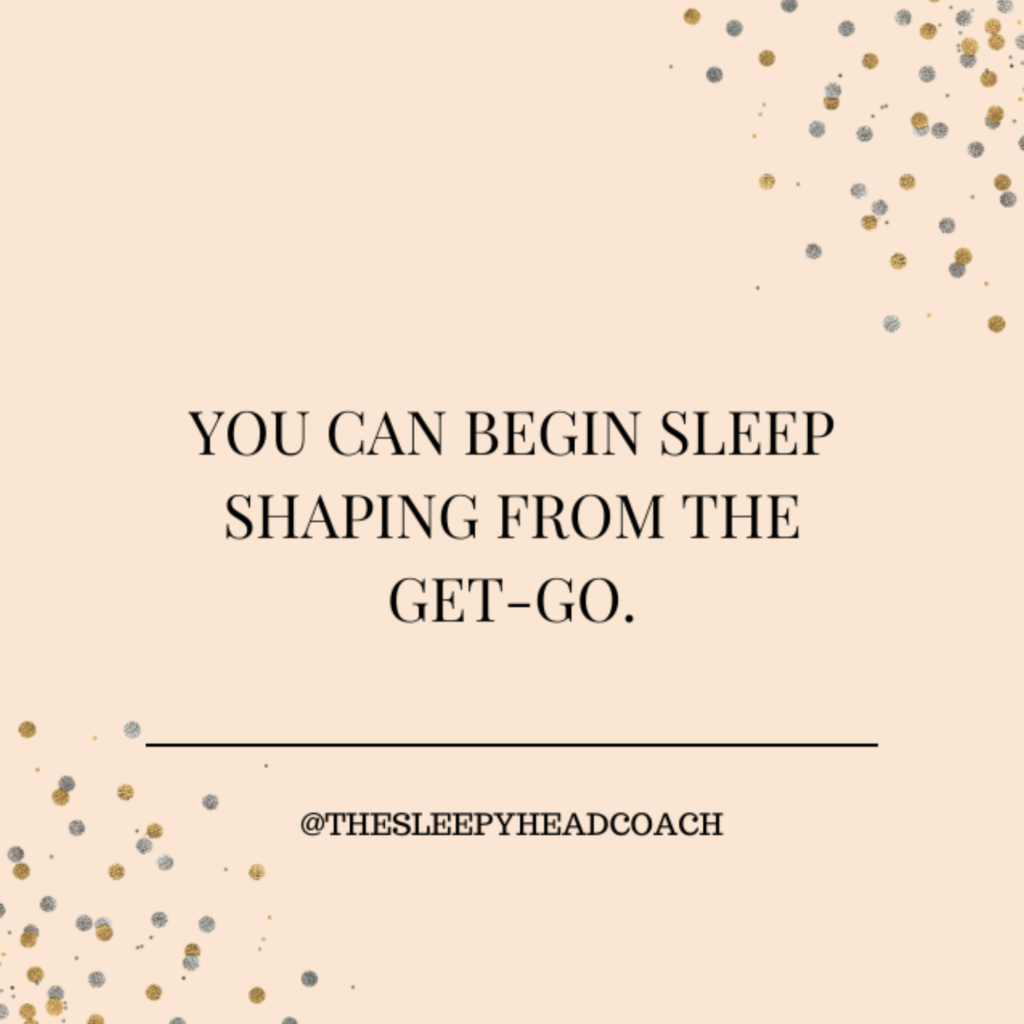While the standard definition of “sleep training” is something you need to wait until baby is 4-6 months old to do, you can start sleep shaping right from birth! My methodology is that by honoring the intrinsic relationship between feedings and sleep while recreating an external environment that is conducive to sleep you can achieve an amazing sleeper who may not then even need formal “sleep training” when they are out of the newborn phase.

My key components of sleep shaping are:
- Tackling day and night confusion: this helps further develop baby’s internal clock. Make the morning bright and exciting and when you are getting ready to put baby down for bed, dim the lights and lower the volume around the house. This helps baby start to differentiate between their days and nights.
- Reading and responding to tired/overtired cues and soothing your baby
- Understanding feeding and sleep expectations based on weight and age – I will never tell you, your baby needs to be or should be sleeping through the night by X months. Your baby is unique and we will show him/her consistency and routines and see what is natural for him/her as a result of that. That could mean a 10-hour stretch at 12 weeks, or 2 overnight feedings at 16 weeks!
- Establishing nap and bedtime routines – repetition breeds results!
- Recreating a safe, womb-like sleep environment
Baby’s Internal Clock
By 8 weeks your baby will likely have formed more predictable circadian rhythms and you can most likely gauge when they will be needing to feed and sleep. If they experienced day and night confusion, by now they would have come out of that and are starting to interact more with their environment during the daytime – hello baby smiles! This is a great time to really start practicing having your baby sleep in the crib more during the day and at night if that hasn’t been established consistently yet. When they start showing tired signs and then see you move them around that time to their room/crib, they will start to associate it with sleep!
Tired CuesThe key here is to respond to tired cues, not get to the point of overtired cues. Tired cues can be as subtle as rubbing their eyes or a yawn. Pay close attention to these cues and sync your bedtime and nap time routines around these, which will start to occur generally at the same time each day.
Feeding + Sleep Relationship
When it comes to infants, I like to follow the “Eat-Play-Sleep” schedule to guide feedings and sleep. It’s important to help baby understand that feeds will come after a nap, so the link between “needing food” and “sleep” isn’t formed (of course this is easier said than done at first due to their wake windows being so short, so don’t worry too much if they continuously fall asleep at the breast). When you are providing full feeds that are age appropriately spaced throughout the day you are setting your baby up for a better night’s sleep!
Routines, Routines, Routines
Sleep shaping is essentially an introduction of routines! Think of the simple, calming steps you want to repeatedly do, in the same order, before placing baby down for bedtime and naps. Even if the time of day isn’t quite consistent, starting to have a consistent routine of what happens before baby goes to bed will drastically help. Even the action of going into baby’s sleep space to begin the routine starts to become a calming pattern to them.
The Ideal Sleep Environment
These are my sleep space must-haves to ensure we create the ideal environment that is most conducive to sleep for our little ones. This is vital for sleep shaping as you are recreating a womb-like environment, which is going to soothe them. – White Noise: Use a continuous white noise machine throughout the night and during nap times. This sleep cue can help them more easily stay asleep if they happened to stir or hear something as it will lull them back to sleep. Avoid nature sounds, we want actual white noise since this mimics how they heard noises while inside the womb for 9 months!- Darkness: The darker the room the easier it will be for your child to enter a deeper sleep – not much light when they were in the womb for 9 months! At first your baby can fall asleep anywhere, but you’ll quickly realize once they start to get particular about naps! – Temperature: Keep the room cool between 68 -72 degrees fahrenheit. And in terms of layers, the general rule is no more than 1 layer more than an adult. If the room is dry, a humidifier is so beneficial and can enhance air flow circulation.⠀⠀
While practice might not make perfect immediately, sleep shaping is a unique opportunity for you to honor that need for bonding with your baby while gently introducing patterns. At first, routines may be flexible as you’re trying different bedtime steps and times. You are learning what works to comfort your baby when they need soothing while at the same time laying the foundation for healthy sleep habits.

